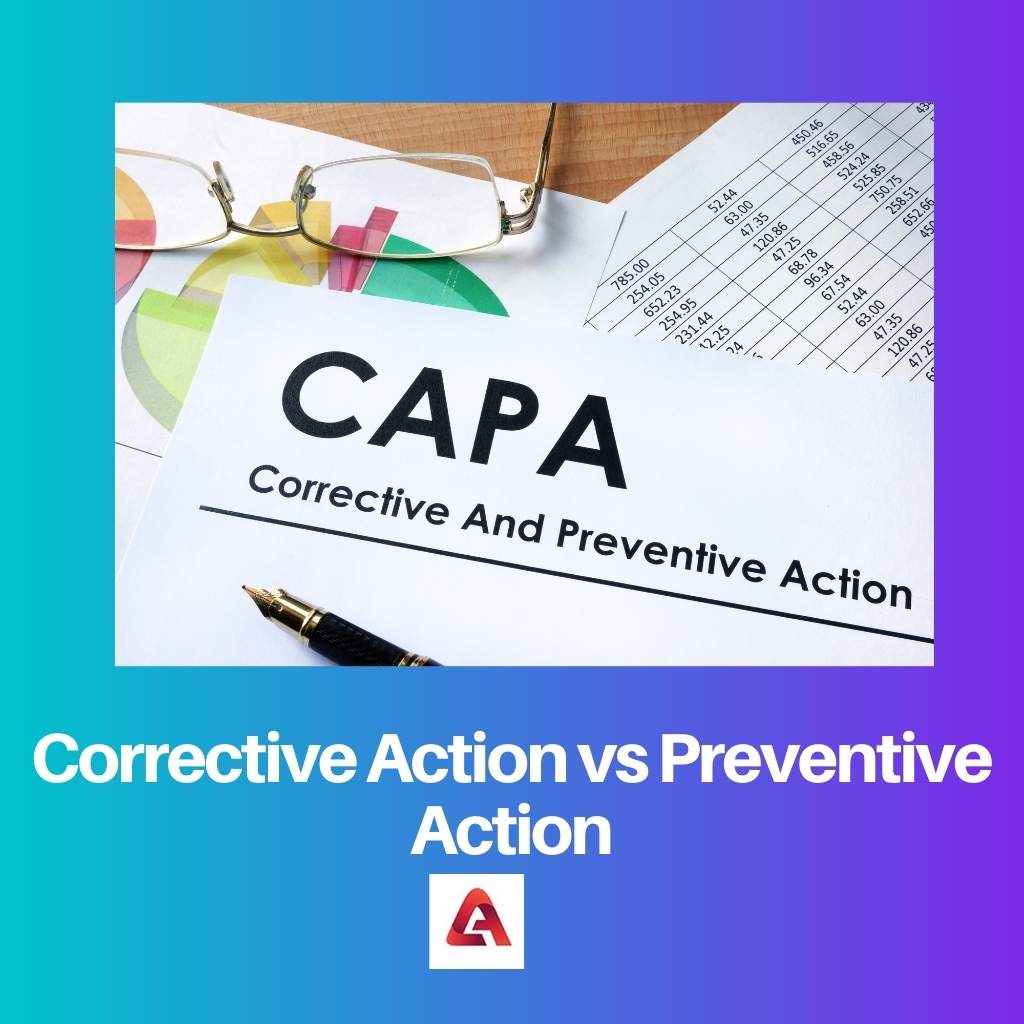Both these concepts were bought into practice for risk-based analysis and analysis of hazards happening. Both are very essential for the after and before of any political, social, or climatic hazardous damage in any country.
Key Takeaways
- Corrective action is taken to correct an existing problem, while preventive action is taken to prevent the problem from occurring in the future.
- Corrective action focuses on addressing the root cause of the problem, while preventive action focuses on identifying potential issues before they occur.
- Corrective action is taken after the problem, while preventive action is taken before the problem occurs.
Corrective Action vs Preventive Action
Corrective action targets existing problems or nonconformities, identifying their root causes and implementing solutions to eliminate them. Preventive action, however, proactively identifies potential issues or risks before they materialize, putting measures in place to minimize or avoid their occurrence, ensuring a smoother, more efficient operation of processes and systems.

A corrective action works in such a manner that it takes into consideration the critical condition of nonconformity that occurs with a certain intensity of risk it generates in an organization.
An action that keeps an eye on focusing on a non-happening of the possibility of a nonconformity so that it does not arise again is known as a preventive action.
Comparison Table
| Parameters of Comparison | Corrective Action | Preventive Action |
|---|---|---|
| Meaning | This is an organization, or a company are plans that are set for identification of the root cause of problems. | This is an organization or a company with a set of activities for the identification of potential risks that might occur in future. |
| Nature | They are reactive. | They are proactive. |
| Activities | This occurs in such a manner that practices such as audits, investigations, and analysis are carried out in an organization. | This takes plan in such a manner that practices such as identifying causes of a particular problem are carried out. |
| Time of occurance | This takes place before the event occurs. | This takes place after the event occurs. |
| Cost | This cost more. | This cost less. |
What is Corrective Action?
To overcome the risk of any nonconformity occurring again, corrective action is taken. A lot of times, an analysis takes the place of nonconformity to happen in the future.
Through internal and external scanning, when a person knows what kind of nonconformity might occur, through the corrective action process, they get to know the intensity of issues that would make this nonconformity happen.
The practice of corrective action helps in reducing the transparency level and also helps in fixing the issue, which sets a benchmark for the future development of an organization.

What is Preventive Action?
The practice of preventive action is an action practised for a no happening of a future uncertain event. In this practice, there is light given to the reinforcement of any related specific process.
This prevention action process, it helps to set the measures and plans to take place when that uncertain nonconformity might take place in the future at a certain point.
The practice of prevention action helps an organization for locating discrepancies. This is done only through Analysing trends and internal auditions through customer reviews.

Main Differences Between Corrective Action and Preventive Action
- The corrective actions in an organization or a company take place before an uncertain event occurs, and on the other hand, prevention action in an organization or a company takes place after the event occurs by pre-planning of measures to be taken.
- The prevention action is less in cost as compared to corrective action, and on the other hand, the other hand, the corrective action is costlier as compared to the prevention action.

- https://academicjournals.org/journal/AJPP/article-abstract/4EF704756791
- https://www.sciencedirect.com/science/article/pii/S0955388699000880

The practice of corrective action is crucial for organizations to address existing problems effectively. Preventive action, on the other hand, is vital for risk mitigation and planning for uncertain events in the future. The article offers in-depth insight into these significant concepts.
I found the comparison table to be highly informative. It clearly highlights the distinctions between corrective action and preventive action in a structured manner.
Absolutely. The article effectively outlines the nature, activities, and time of occurrence of corrective action and preventive action, making it easier for readers to comprehend the differences.
The article effectively explains the key takeaways of corrective action and preventive action. It’s valuable to understand the nature, activities, time of occurrence, and costs associated with these crucial concepts.
I found the discussion on the main differences between corrective action and preventive action to be particularly enlightening. It’s essential knowledge for professionals involved in risk-based analysis.
The article provides an insightful overview of corrective action and preventive action, emphasizing their significance in addressing and preventing problems within organizations. The main differences between the two are well-explained.
Absolutely, the article effectively communicates the essential aspects of corrective action and preventive action. It’s a valuable resource for understanding how organizations can approach risk-based analysis.
This is a very interesting article. I appreciate the clarification regarding corrective action and preventive action. The comparison table is particularly effective for understanding these concepts.
I agree. The article provides the reader with a clear understanding of how corrective action and preventive action differ and their significance.
The article’s focus on the different aspects of corrective action and preventive action, including their nature, activities, time of occurrence, and cost, provides readers with a comprehensive view of these essential concepts within risk-based analysis.
Absolutely. The article lays out the essential elements of corrective action and preventive action systematically, making it a valuable resource for individuals seeking to enhance their understanding of risk mitigation.
The article provided an in-depth analysis of corrective action and preventive action, offering a comprehensive understanding of their implementation and benefits within organizations.
Absolutely. The details regarding corrective action and preventive action enable readers to grasp the significance of proactive and reactive approaches to addressing risks and nonconformities effectively.
The references provided in the article add credibility to the content and demonstrate the scholarly foundation of the discussion on corrective action and preventive action.
I agree. The inclusion of academic references enhances the reliability of the information presented and offers readers avenues for further exploration of the topic.
The detailed explanation of corrective action and preventive action in the article is commendable. It clearly articulates the significance of addressing existing problems and preventing potential risks in organizations.
The article does an excellent job of differentiating between corrective action and preventive action, shedding light on their distinct nature and purposes.
I couldn’t agree more. The descriptions and examples provided for corrective action and preventive action are useful for understanding their applications in organizational settings.
The article effectively outlines the benefits and applications of corrective action and preventive action in organizational contexts. The comparison table is particularly valuable for understanding the differences between the two approaches.
Absolutely. The detailed comparison between corrective action and preventive action table provides clarity on their distinct features and functions, contributing to informed decision-making within organizations.
The practical examples provided for corrective action and preventive action demonstrate their real-world applications and significance in mitigating organizational risks.
The article’s emphasis on the main differences between corrective action and preventive action, along with practical examples and references, makes it a compelling and informative read for professionals across various industries.
The detailed breakdown of corrective action and preventive action in the article facilitates a deeper understanding of their applications, enabling professionals to make informed decisions for risk management.
I couldn’t agree more. The article’s comprehensive coverage of corrective action and preventive action provides professionals with actionable insights into addressing and preventing nonconformities and risks in their organizations.